
This page last modified: 1 November 2015 (references updated)

 Above: Frontpiece from the Bodleian manuscript (O). The stations depicted are: Othona, Dubris, Lemannis, Branoduno, Garaianno, Regulbi, Rutupis, Anderidos, Portum Adurni. |
The following officers along with their units are listed as being under the command of the Count of the Saxon Shore of Britain (the numbers in front of the names refer to Ingo Maier's numbering scheme):
132.2 Praepositus numeri Fortensium, at Othonae |
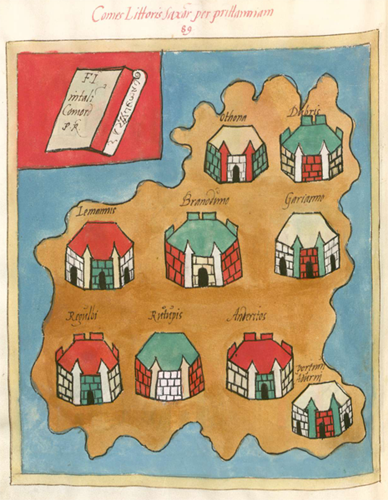 Above: Frontpiece from the Munich manuscript (W). In contrast to the contemporary (i.e. 15th-century) Italianate appearance of the Bodleian frontpiece, that from (W) is believed to be closer to the lost Codex Spirensis version, at least in style, despite W's later (mid-16th century) date. |
Note 1. Uetasiorum in item 132.7 was amended by Seeck (Oc.XXIII.18) to [Ba]etasiorum, and this has been accepted by all subsequent commentators, as that name is firmly established from epigraphic sources, e.g. RIB 830 ("COH I BAETASIORVM C R); RIB 843 ("COH I BAETASIOR C R); and CIL 16,48 ("I BAETASIORVM).
Note 2. The locations Rutupis and Anderidos are absent from all copies of the textual list, but as they do appear in the frontpiece as forts illustrating the locations under the command of the Comes, it has been recognised since at least Boecking's edition that their names can be easily supplied in the appropriate places.
All of the units listed under the Comes litoris Saxonici per Britanniam are limitanei(i.e. garrison as opposed to field army) units. However, as discussed below, it seems that some of these units might be the same as some of the pseudocomitatenses units of the Gallic field army commanded by the Magister Equitum that are not listed as being drawn from those of the Magister Peditum's infantry roster.
The men under the Praepositus numeri Fortensium (132.2), at Othonae (Othona, modern Bradwell, and formerly called Ythanceaster) were posited to be a detachment of Legio II Traiana Fortis by Boecking as long ago as the mid-19th century; detachments of the Legio secunda Traiana can be found so-named in the Notitia (56/7.13) stationed at Appollonos superioris under the Dux Thebaidos, and at Parembole under the Comes limitis Aegypti (52.7). Hassall assumed they were cavalry, since they are recorded as being a numerus, citing the examples of the Cuneus equitum Fortensium (143.6) under the Dux Valeriae ripensis and the Cuneus equitum Dalmatarum Fortensium (80.2) under the Dux Daciae ripensis as examples of units called Fortenses that are "clearly" mounted. However, numerus need not be restricted to mounted units (it means simply "a number/body (of troops)"; indeed, numerous inscription exist to numeri that are undoubtably infantry units, even elite legions like the Ioviani (cuneus, on the other hand, does appear to be restricted to mounted units in the Notitia). Further, as Hassall himself pointed out, Legio II Traiana need not be the only unit providing detachments that came to be named Fortenses in the Notitia. Unfortunately, no epigraphic evidence has been recovered from the fort at Bradwell to give further clues as to the origins of this unit. That the unit is commanded by a generic praepositus ("commander") as opposed to a praefectus lends weight to an argument against it being a legionary unit; however.
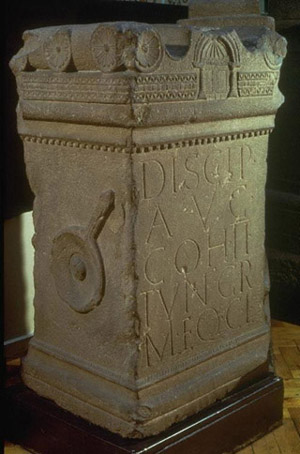 |
The men under the Praepositus militum Tungrecanorum (132.3), at Dubris (modern Dover) seem to originally have been a unit of Tungri/Tungrecani/Tongrecani; the name originates from the Tongres region in Belgium. The Notitia apparently lists two such units in Britain: in addition to the Dover unit, we find a Tribunus cohortis primae Tungrorum (154.24), at Borcovicio (Vercovicium, modern Housesteads) under the Dux Britanniarum. Epigraphic evidence for this Cohors I Tungrorum millaria is extremely plentiful; we also have epigraphic evidence, not so plentiful, but still amounting to over a dozen inscriptions, for a Cohors II Tungrorum milliaria equitata, which might equate to the Dover unit, although all the epigraphic evidence for it comes from the north of England, and not the south. There is unfortunately no epigraphic evidence from Dover mentioning the identity of its garrison. In 1976, Hassall posited a lacuna in the Dux Britanniarum's list covering this very unit which has become widely accepted; see under the Dux Britanniarum for details. This would imply the Dover unit is actually a third unit. However, this can be easily explained if the two Dux' units are the Cohors I Tungrorum millaria and infantry portion of the Cohors II Tungrorum milliaria equitata, while the Comes' unit is the mounted portion of the Cohors II Tungrorum milliaria equitata. An altar from Birrens (RIB 2092 = AE 1987, 60) dedicated by the men of COH II MIL EQ has a carving apparently showing a patera (libation bowl) on the side, although the handle is somewhat unusual (see the picture to the left). However, its apparent "boss" makes me wonder if it is consciously echoing a shield, as the concentric rings are typical of many Notitia patterns (many such vessels found in non-military situations also show such a boss, it must be said, which appears to have facilitated holding the vessel, but as this one has a handle, such as functional element would seem to be unnecessary).
Elsewhere in the Notitia, a unit of auxilia palatina called the Tungri (98/9.93) is found in the apparently newly-created force under the Comes Illyricum; these might well be the same men as (formerly) found under the Tribunus cohortis primae Tungrorum; its shield pattern is rather similar to that of the Birrens altar patera shown to the left. I used to think there was a chance that the Latini (98/9.69) under the same commander are the men under the Praepositus militum Tungrecanorum since it has been postulated from epigraphic evidence that the cohors II Tungrorum milliaria equitata was awarded the very unusual title civium Latinorum, as opposed to the frequently found civium Romanorum; however, the presence of a unit called the Sabini (98/9.70) adjacent to the Latini in the Magister Peditum's infantry roster argues agains this hypothesis; see the Latini page for more details. Finally, there is an elite legio palatina called the Tongrecani seniores (98/9.24) in the Magister Peditum's Italian command which is unlikely to have anything to do with the British units other than sharing an initial recruitment area name, as it is a legionary unit, while the British cohortes are auxiliary units. Nonetheless, Hassal suggested the Dover unit may have been the Tongrecani iuniores, which, although mentioned by Ammianus is conspicuously absent from the Notitia. Given the legionary-auxiliary status mismatch, however, I consider it more likely that the Tungrecani iuniores was simply destroyed at some point in the 50-odd years between Ammianus' work being finished and the final revisions of the Notitia. That units such as "Tungrians" replenished their ranks with men from outside their initial recruiting area can be see in the case of Cohors II Tungrorum milliaria equitata, for which an altar stone has been found (RIB 2100 = CIL 7, 1068) in Birrens mentioning the soldiers serving in the unit who were Raetians (i.e. men from the region of modern Austria): the C(ives) RAETI MILIT(antes) IN COH(orte) II TUNGR(orum). |
The men under the Praepositus numeri Turnacensium (132.4), at Lemannis (Portus Lemanis, modern Lympne) appear to have a name originating in Turnacum (modern Tournai in Belgium). The only inscriptional evidence from Lympne (RIB 66) mentions the prefect of the British fleet stationed there in ca. 125 AD (the PRAEFECT(us) CLAS(sis) BRIT(annicae)), but nothing has been found relating to a land garrison. It is possible the Numerus Turnacensium is to be equated with the Truncensimani (102/5.160) of the Magister Equitum's Gallic command, although it is usually assumed that the origin of the Truncensimani is with Legio XXX Ulpia, which was stationed at Tricensimae (Xanten in Germany) in the 4th century. Parallels for similar spelling mistakes can be found in the Notitia.
The men under the Praepositus equitum Dalmatarum Branodunensium (132.5), at Branaduno (Branodunum, modern Brancaster) are clearly a "Dalmatian" cavalry unit; this type of unit was seemingly first raised by Gallienus in the 260s, although exactly what is meant by "Dalmatian" is unclear. No inscriptional evidence for this unit exists, although roof tiles (AE 1976,374; RIB 2466, 1 & 2) have been found at Brancaster bearing the name of the unit that apparently built the fort prior to the establishment of the the Saxon shore command: C(o)H(ors) I AQ(uitanorum). Another unit of Equites Dalmatarum was stationed in Britain according to the Notitia (154.3), at Praesedio (perhaps Bridlington), under the Dux Britanniarum. Both of these units may have been former alae stationed in Britian repurposed and renamed.
The men under the Praepositus equitum stablesianorum Gariannonensium (132.6), at Gariannonor (probably modern Burgh Castle, but possibly Caister-on-Sea) have also left no inscriptional evidence, and the fort is mentioned in no ancient source outside the Notitia (and yet the Roman ruins at both Burgh and Caister feature walls over 4 metres high, so are hardly minor features!). They are probably to be equated with the Equites stablesiani (102/5.254) assigned to the Comes Britanniarum, as the only units of Equites stablesiani included in the Magister Equitum's cavalry roster, the Equites stablesiani Africani (102/5.23) and the Equites stablesiani Italiciani (102/5.41), are both assigned to far-off Africa. Exactly what is meant by "stablesiani" (beyond a trite translation of "pertaining to stables") is still debated; see here.
The men under the Tribunus cohortis primae [Ba]etasiorum (132.7), at Regulbio (Regulbium, modern Reculver in Kent) belong to a cohort that was presumably recruited from among the Baetasii tribe in Germany in the late 1st century; an altarstone from Maryport in the north of England gives (RIB 838) the name of the unit as COH(ors) I BAESTASIORUM C(ivium) R(omanorum). Although it has no left no inscriptional evidence for its stay at Reculver, tilestamps nonetheless show its presence there (RIB 2468). As noted above, the manuscripts actually give the unit's moniker as "Vetasiorum", and not "Baetasiorum".
The men under the Praefectus legionis secundae Augustae (132.8, and presumably at Rutupis/Rutupiae, modern Richborough in Kent) are clearly from Legio II Augusta. This legion dates back to Octavian (who was later styled the emperor Augustus, hence the unit's epithet), and was one of the units involved in the invasion of Britain in 43 AD; it remained in Britain for over three and half centuries. Legio II Augusta (or at least a detachment thereof), is likely to be equated with the Secundani iuniores (102/5.208) under the Comes Britanniarum, and by extension the Legio secunda Britannica siue Secundani (98/9.115) of the Magister Peditum's infantry list and the Secundani Britones (102/5.136) of the Magister Equitum's Gallic command. This last, was questioned by Hassal since "Britones" sounds more like a tribal name than a geographical one, implying non-legionary status, but I think the fact that the Legio secunda Britannica is explicitly said by the Notitia to be also known as the Secundani removes this objection (it is not necessarily obvious, however, that this is the case, because Seeck bracketed the vital "or Secundani" from his edition as something to be deleted!). Interestingly, the archaeological evidence implies that the fort at Richborough is a mere one-tenth the size of the one that the Legio II Augusta occupied in earlier times at Caernarvon, which might suggest that the legion stationed there was much diminished in size. However, the number of coins found at Richborough dating to ca. 400 AD is significantly greater than at any other British archaeological site, which would attest to its continued importance at the time the Notitia was drawn up. The small size of the fort is more likely an indication that it was the unit's headquarters that were stationed there, as opposed to the entirety (or even just the bulk) of the unit.
The following shield pattern for Legio II Augusta can therefore be taken from that given under the Magister Peditum, assuming the unit was not given a new shield pattern when it was withdrawn from Britain and assigned to the Gallic field army (which it likely was...):

That under O comes from the Bodleian manuscript in Oxford, that under P from the Paris manuscript, that under M from the first portion of the Munich manuscript, that under W from the second portion of the Munich manuscript, and that under B from the Froben edition.
The men under the Praepositus numeri Abulcorum (132.9, and presumably at Anderidos, modern Pevensey) have a name that looks like it might be tribal in origin, perhaps German; however, the name also been connected with Avila in Spain. No Roman inscriptions have been found at Pevensey, and stamped roofing tiles bearing the legend "HON AUG ANDRIA" have been shown to be forgeries. A unit called the Abulci is mentioned as leading the fighting at the battle of Mursa in 351 by Zosimus, but whether this is connected with the British unit is unknown. However, in the Notitia two units bear names suggesting they were previously stationed at Pevensey: the men under the Praefectus militum Anderetianorum, part of the command of the Dux Mogontiacensis; and the men under the Praefectus classis Anderetianorum, stationed at Paris, although not part of the Magister Equitum's Gallic command. The Pevensey Numerus Abulcorum is very likely the same unit as the Abulci under the Magister Equitum's Gallic command (102/5.161), withdrawn from Britain.
The men under the Praepositus numeri exploratorum (132.10), at Portus Adurni (modern Portchester), have left no inscriptional evidence there, and neither has any other unit. Another unit of Exploratores (i.e. "scouts", or "reconnaissance troops") is recorded in the Notitia as being stationed in Britain: the men under the Praefectus numeri exploratorum (154.9), at Lavatres (modern Bowes), under the Dux Britanniarum. Inscriptional evidence also happens to give two units of Exploratores in Britain: the N(umeri) EXPLOR(atorum) BREMEN(iensium) from an altarstone (RIB 1270) found at Bremenium (modern High Rochester); and a unit of EXPL[oratores Habitacenses], from a dedicatory inscription of 209 AD (RIB 1235 = CIL 7.1002) from Habitancum (modern Risingham); they are also called the plain [n]UME[rum e]XPLOR[ator(um)]) on a building stone (RIB 1243 = CIL 1010) from the same place. Which of these two units corresponds to which Notitia unit is unclear. However, since the Magister Equitum's Gallic command has a unit of Exploratores listed after the Abulci, these two units seem to be paired, just as the Numerus Abulcorum and the Numerus exploratores are (or were) paired under the Count of the Saxon Shore of Britain, and thus it seems reasonably certain it is the Portchester unit that was assigned to the Gallic field army (although it is conceivable the Bowes unit may have been folded into it). Note that there are only two other units of exploratores listed in the Notitia: the men of the Praefectus militum exploratorum (78.25) under the far-away Dux Moesiae primae, and another such unit (80.18) under the even further-off Dux Daciae ripensis.
Below are shown the frontpieces from the Parisian manuscript, P; the Froben printed edition, B; and the first set of pictures in the Munich manuscript, M:
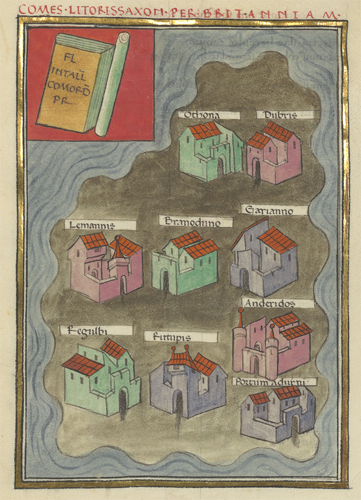
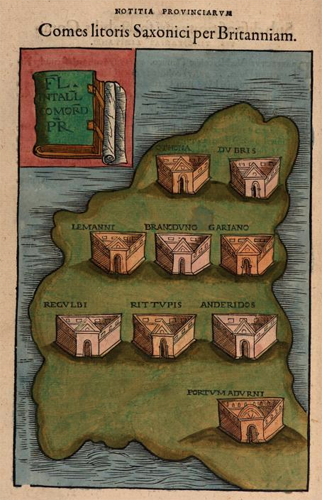

And below is a map showing the locations of the nine units under the Comes litoris Saxonici per Britanniam, with each map number ("X") corresponding to the appropriate Notitia entry: 132.X.
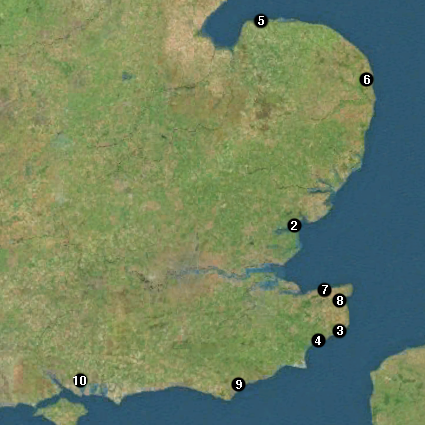
1. Ingo Maier; "Appendix 4: Numeration of the new edition of the compilation 'notitia dignitatum' (Cnd)"; last accessed 26 October 2015. See also for here for numbering examples. Return
2. Otto Seeck (Ed.); "Notitia Dignitatum accedunt Notitia urbis Constantinopolitanae et Latercula prouinciarum", Weidman, Berlin (1876); available here (last accessed 1 November 2015). Return
3. Eduard Boecking; "Notitia dignitatum et administrationum omnium tam ciuilium quam militarium in partibus orientis et occidentis", Adolph Marcus, Bonn, 3 Volumes + Index (1839-1853); Volume 1 (the East; 1839) available here;
Volume 2 (the West, part 1; 1840) here;
Volume 3 (the West, part 2; 1850) here; Index (1853) here and also here (last accessed 1 November 2015). Return
4. M.W.C.Hassall, p 7-10 in "BA Research Report No. 18, The Saxon Shore"; Ed. D.E. Johnston (1977); available here (last accessed 1 November 2015). Return
5. M.W.C. Hassall; "Aspects of the Notitia Dignitatum", Oxford, 1976; at p 113. Return
6. Ammianus Marcellinus ("Ammianus"); "Res gestae a fine Corneli Taciti", 26.6.12; available here in Latin and here in English (last accessed 27 October 2015). Return
7. The Roman Britain Organisation; "Anderitum" (link dead as of 1 November 2015). Return
8. Zosimos ("Zosimus"); "Historia Nea", 2.52; available here (in Greek) and here (in English; 1814 translation from an inferior Greek manuscript; last accessed 1 November 2015). Return

Return to the Notitia index page.